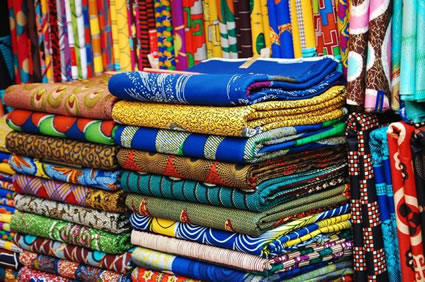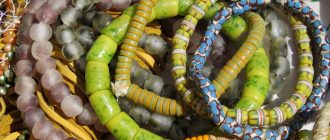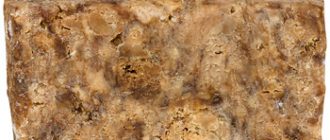Batik
Ghanaian batik evolves from a process of coloring cloth using wax to block dye from reaching certain parts of the cloth. This popular method of coloring and printing fabric involves dying, drying and boiling the cloth to remove the wax. The places that had wax will remain the original color, while the rest obtains the new color. The art of batik work has for generations been passed down in Ghana, with each of the 10 regions producing their own unique colors and patterns.
Cotton
In the mid-1970s, Ghana experienced a rapid expansion in cotton production. With the reorganization of the Ghana Cotton Development Board into the Ghana Cotton Company, cotton production has again steadily increased from 4% to 50% of the country’s national requirement. Today, a lot of cotton is produced, which is able to meet the country’s need for creating beautiful kente fabric.
Designs
With regards to designs, Ghanaian fashion doesn’t fail to impress. The style of dress for Ghanaian women comprises of practical yet fashionable outfits. There are 3 traditional styles for women’s dress in Ghana: the long dress, wrap and skirt and top set. Ghanaian fashion for men comprises often of tunics, short or long sleeved, as well as loose drawstring pants.
Dresses
Despite western influence, the people of Ghana today continue to dress in the traditional styles inspired by their ancestors. Most Ghanaian dress styles are hand-woven, hand-dyed and hand-sewn by professional seamstresses. The end result is Ghanaian dress that is custom-made to fit the unique shape of the wearer. Most clothing in Ghana is made from sturdy fabrics such as cotton, which are rich in detail and colour.
Tie dies
Friday in Ghana was declared by the government to be a day to wear Ghanaian clothing. Most Ghanaians who recognize this opt to wear tie dyed or batik shirts. Although there are machine made tie dyes, this design technique persists as a home based industry that is carried out in the yards of the designers. A good example of tie and dye in Ghana is the fugu, the traditional garment of men from northern Ghana. The fugu is a loose fitting tunic that is made from hand-woven cotton strips. At Daboya village near Tamale in Ghana’s northern region, you can watch the indigo tie and dying process. This involves wrapping sections of cotton yarn in leather to create an area that will resist the dye. Thereafter, the cotton yarn is soaked in large, open-air vats of indigenous indigo. The yarn is laid out in the sun to dry. It may then be sewn and woven into fugus.
Funeral
Just as with most other aspects of Africa, funerals are creative and colorful affairs designed to affirm the continents powerful beliefs and traditions. In Ghana, there are textile prints that are specifically designed for funeral purposes. For instance, the “Se Asa” fabric which literally means “it’s ended” is a popular choice during funerals. Available in colors such as red, black, red and black and white and black colors, Ghanaian funeral fabric can be colorful. Other designs that are commonly chosen during funerals in Ghana include the Agya Atta, Asomdwehene; Damirifa due; Onipa Nni aye; and Kokonsani bebre.
Kente
Kente is a cloth that is local to Ghana. Originally worn by Ghanaian royalty, kente is today available for anyone who can afford it. The cloth is hand woven in wooden looms to produce a fabric of very high quality. Available in various colors, designs and patterns, every different piece of kente cloth carries its own unique meaning. Ghanaian mythology has it that the very first kente cloth was created by two friends who watched how a spider wove its web. The weavers then created the kente cloth by mimicking the actions of spiders. Whether true or not, this story is great in highlighting the harmony that the people of Ghana share with Mother Nature.
Lace
Lace is a popular fabric amongst Ghanaians and other people from West African nations including Nigeria. Ghanaian lace is adorned on the edges of another fabric with openwork to provide the fabric with a unique exotic and valuable appearance. Ghanaian lace comprises of a heavily patterned or embroidered fabric that may sometimes have holes that are made by machine or hand. Lace from Ghana will often have rhinestones or sequins that add a touch of glitter to the fabric. The background of the lace fabric may be Voile (100% cotton, with a soft feel), Poly-Voile (relatively rough fabric) or Organza (like silk but stiffer).
Markets
The main cloth market for Ewe kente cloth in Ghana is situated in Agbozume, which is near the border with Togo. The market opens every fifth day and attracts traders and buyers from all over West Africa and beyond. Bolga market is a good market for shopping for a wide variety of fugus from all across the region. Here, you can also see the fugus sewn by the weavers.
Wax print
Wax print fabrics are today very much a part of West African culture. Unlike the cassava paste that is used in the creation of tie dyes in Nigeria, Ghanaian designers tie and dye their cloths using wax and commercial dyes. The fabric itself is often made out of cotton that is locally grown. The final product is a vibrantly colored and designed piece of fabric that is ideal for any type of textile project including making dresses and quilting.
Patterns
One popular pattern for Ghanaian cloth is Adinkra. Unique to Ghana, adinkra is believed to have begun around 1800 with designs being carved into a small piece of calabash, dipped in a black tar substance and stamped onto cotton cloth. The black tar dye was made by boiling bark of the badie tree for 2 days. Adinkra patterns have meanings which are typically based on African proverbs. In earlier times, it was possible to order a cloth with a message relayed by the specific stamps used. There are numerous adinkra meanings available today, although most people buy the cloth taking whatever appeals to them.





